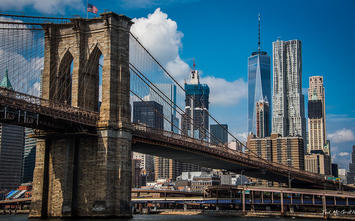
In a year when two boosters of the “luxury city,” Donald Trump and Michael Bloomberg, are vying to run the whole country, the very model that created their “success” is slowly unraveling. After roughly 20 years of big-city progress, measured by economic growth and demographic progress, the dense urban centers, including New York, are again teetering on the brink of decline.
Long associated with glamour, money and cultural influence, the rise of the luxury city has foundered on the rocks of inequality and, increasingly, diminished upward mobility. Indeed, according to Pew research, the greatest inequality now exists in superstar cities such as San Francisco, New York, Los Angeles, and San Jose. Rather than working to create and sustain a middle class, as Jane Jacobs once suggested, by building local economies, these cities have depended on luring both the ultra-rich and the young and ambitious of the global marketplace to secure and enhance their place.
This approach worked somewhat in the first decade of the millennium, as illustrated by a remarkable rise in New York City’s newly listed condo prices over the last decade from $1.15 million to $3.77 million. But the gold rush is fading now, in part due to the decline of globalization which is also weakening the economies of rival global capitals like London and Hong Kong. Today, as The Atlantic recently noted, Manhattan now suffers conditions where “the homeless shelters are full, and the luxury skyscrapers are vacant.”
Even the world’s arguably most influential urbanist, scholar Richard Florida, agrees that the great urban revival is “over.” Since 2010, urban inner rings, including central business districts, accounted for barely 10 percent of population growth in the nation’s 53 largest metropolitan areas. More revealing still, the country’s three largest metropolitan areas — New York, Los Angeles, and Chicago—are now losing population. Since 2012, suburbs and exurbs, which have seven times as many people as the core, are again growing faster. Suburbs are also seeing a strong net movement among educated people, those earning over $75,000 and especially those between the ages of 30 and 44. Far from being dead, as often asserted in the big city media, a new Harvard study shows that over the past 40 years the periphery has increased its lead in terms of wealth and jobs compared to core cities.
The changing dynamics of millennial migration—long held as the secret sauce powering inner-city revivalism—represent perhaps the most ominous sign of things to come. Dense, high-priced cities, the object of endless love from architectural critics like The New York Times’ Michael Kimmelman, do still attract many talented young people straight from college, but many don’t stay long, and increasingly are seeking out other, less dense and more affordable places. A recent Brookings study shows that New York now suffers the largest net annual outmigration of post-college millennials (ages 25–34) of any metro area, followed by Los Angeles, Chicago, and San Diego. The biggest gains, outside Seattle, have been concentrated in the central and mountain time zones in places like Austin, Dallas, Houston and Denver.
Read the rest of this piece at The Daily Beast.
Joel Kotkin is the Presidential Fellow in Urban Futures at Chapman University and Executive Director for the Center for Opportunity Urbanism. His last book was The Human City: Urbanism for the Rest of Us (Agate, 2017). His next book, The Coming of Neo-Feudalism: A Warning to the Global Middle Class, is now available to preorder. You can follow him on Twitter @joelkotkin
Photo credit: Ted McGrath via Flickr under CC 2.0 License.












